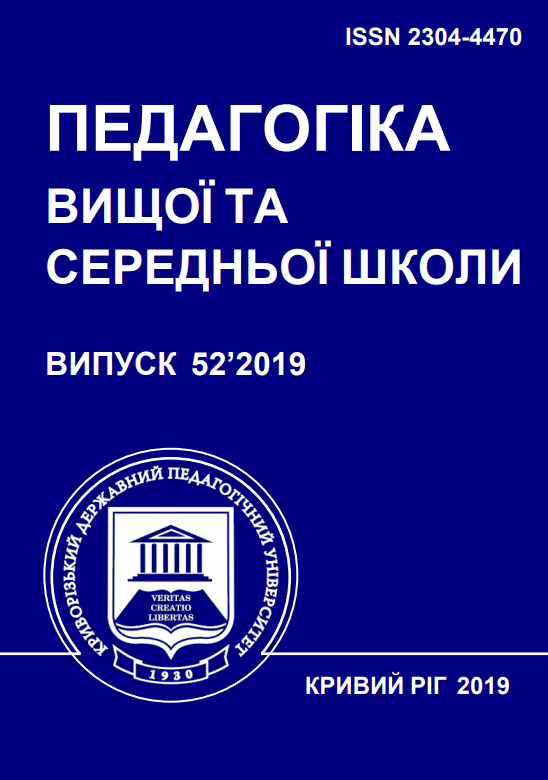E-learning resources for successful math teaching to pupils of primary school
DOI:
https://doi.org/10.31812/pedag.v52i0.3804Keywords:
tools and apps, teaching Math, young learners, primary school, experimental researchAbstract
Ukrainian primary schools are undergoing significant changes as for Reform ‘New Ukrainian School’, it reflects rapid updating information technology and high level of children’ informational activity. Primary schools are basically focused on development subject knowledge and general study skills. One of the ways of their developing is to use tools and apps. There are the examples of using interactive tools and apps for teaching Math for young learners by teachers-to-be in the article. The article presents as well the experimental data about training teachers-to-be to use tools and apps. Interactive tools and apps provide real task variability, uniqueness of exercises, operative assessment of correction, adjustment of task difficulty, a shade of competitiveness and gaming to the exercises. To create their own apps teachers-to-be use the tools that are the part of the integrated Microsoft Office package using designing environments, and other simple and convenient programs. The article presents experimental data about the results of training
teachers-to-be to create apps. A set of criteria for creation apps was made and checked at the experimental research such as ability to develop apps, knowledge and understanding the functional capabilities of apps, knowledge of tools for creating apps and their functional capabilities, ability to select and formulate tasks for young learners, ability to assess adequately the quality of the developed apps.
Downloads
References
Alayyar, G. M., Fisser, P., Voogt, J.: Developing technological pedagogical content knowledge in pre-service science teachers: Support from blended learning. Australasian Journal of Educational Technology
(8), 1298–1316 (2012). doi: 10.14742/ajet.773 DOI: https://doi.org/10.14742/ajet.773
Belousova, L. I., Olefirenko, N. V.: Didakticheskii potentcial tcifrovykh obrazovatelnykh resursov dlia mladshikh shkolnikov (Didactic Potential of Digital Educational Resources for Young Schoolchildren). Obrazovatelnye tekhnologii i obshchestvo 16 (1), 586–598 (2013).
Bilousova, L. I., Gryzun, L. E., Sherstiuk, D. H., Shmeltser, E. O.: Cloud-based complex of computer transdisciplinary models in the context of holistic educational approach. In: Kiv, A. E., Soloviev, V. N. (eds.)
Proceedings of the 6th Workshop on Cloud Technologies in Education (CTE 2018), Kryvyi Rih, Ukraine, December 21, 2018. CEUR Workshop Proceedings 2433, 336–351. http://ceur-ws.org/Vol-2433/paper22.pdf (2019). Accessed 10 Sep 2019.
Calloway, D. L.: Instructional Design (ID) Principles, Their Interrelationships, & the Overall Process of Designing Effective Instruction. https://www.academia.edu/681000/Instructional_Design _Principles (2009). Accessed 21 Mar 2019.
Dym, C. L., Agogino, A. M., Eris, O., Frey, D. D., Leifer, L. J.: Engineering Design Thinking, Teaching, and Learning. Journal of Engineering Education 94 (1), 103–120 (2005). doi: 10.1002/j.2168- 9830.2005.tb00832.x DOI: https://doi.org/10.1002/j.2168-9830.2005.tb00832.x
Hlushak, O. M., Proshkin, V. V., Lytvyn, O. S.: Using the e-learning course “Analytic Geometry” in the process of training students majoring in Computer Science and Information Technology. In: Kiv, A. E., Soloviev, V. N. (eds.) Proceedings of the 6th Workshop on Cloud Technologies in Education (CTE 2018), Kryvyi Rih, Ukraine, December 21, 2018. CEUR Workshop Proceedings 2433, 472–485. http://ceur-ws.org/Vol-2433/paper32.pdf (2019). Accessed 10 Sep 2019.
Hughes, J., Daniels, N. (eds.): TACCLE 2 e-learning for primary teachers: A step-by-step guide to improving teaching and learning in your classroom. http://taccle2.eu/download/e-learning-for-primary-teachers-copy?wpdmdl=17078&refresh=5d6a7500437391567257856 (2013).
Information and Communications Technology (ICT) in the Primary School Curriculum: Guidelines for Teachers. https://web.archive.org/web/20171121192230/http://www.ncca.ie/uploadedfiles /PublicationsICTPrimary.pdf (2005). Accessed 21 Mar 2019.
Markova, O. M., Semerikov, S. O., Striuk, A. M., Shalatska, H. M., Nechypurenko, P. P., Tron, V. V.: Implementation of cloud service models in training of future information technology specialists. In: Kiv, A. E., Soloviev, V. N. (eds.) Proceedings of the 6th Workshop on Cloud Technologies in Education (CTE 2018), Kryvyi Rih, Ukraine, December 21, 2018. CEUR Workshop Proceedings 2433, 499–515. http://ceur-ws.org Vol-2433/paper34.pdf (2019). Accessed 10 Sep 2019.
Olefirenko, N.: Use GeoGebra in primary pupils training. GeoGebra International Journal of Romania 2 (2), 49–55. http://ggijro1.files.wordpress.com/2012/11/olefirenko20121.pdf (2013). Accessed 21 Mar 2019.
Primary Mathematics with ICT: A pupil’s entitlement to ICT in primary mathematics. Becta, Coventry (2009).
Romanosky, O. G.: Pedahohika uspikhu: yii sutnist ta osnovni napriamy vyvchennia (Pedagogics of success: its essence and basic directions of study). Teoriia i praktyka upravlinnia sotsialnymy systemamy 2, 3–8 (2011).
Sipil ̈a, K.: Educational use of information and communications technology: teachers’ perspective. Technology, Pedagogy and Education 23 (2), 225–241 (2014). doi: 10.1080/1475939X.2013.813407 DOI: https://doi.org/10.1080/1475939X.2013.813407
Downloads
Published
Issue
Section
License
Copyright (c) 2019 Надія Олефіренко, Ілона Костікова, Наталія Пономарьова, Андрій Пікільняк

This work is licensed under a Creative Commons Attribution 4.0 International License.




